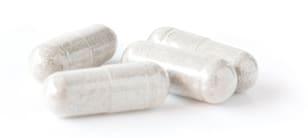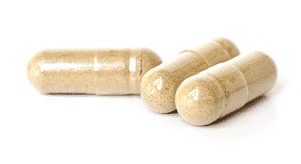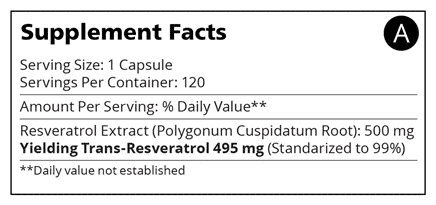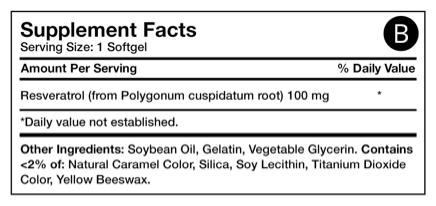RESVERATROL A TO Z
Answers to the most common questions about resveratrol
- What is resveratrol?
- What is trans-resveratrol isolate?
- What is “pure” resveratrol?
- Does Mega Resveratrol contain emodin?
- What are the sources of resveratrol?
- Why is Mega Resveratrol more expensive than other resveratrol?
- What is “micronized” resveratrol?
- Does resveratrol cause side effects?
- Will resveratrol interact with other medications?
- What is the recommended dosage?
- How should I take resveratrol?
- How should I store resveratrol capsules and powder?
- What is the stability of resveratrol?
- What is Resveratrol plus FruiteX-B?
- Do you ship with an ice pack?
- Do you ship to all countries?
- What is the cost of shipping?
- What is the return policy?
WHAT IS RESVERATROL?
Resveratrol is a type of polyphenol found in a variety of commonly eaten foods, including grapes, Japanese knotweed (giant knotweed), berries, peanuts, dark chocolate, and tea. It first gained attention in the early 1990s when the CBS show 60 Minutes aired a segment on “the French paradox” – investigating why French people, despite eating diets high in saturated fat, had lower rates of coronary heart disease than their American counterparts. The report concluded that higher consumption of red wine may play a pivotal role in lowering the incidence of coronary heart disease. Researchers pointed to resveratrol, found in grape skins, as the compound thought to prevent or delay coronary heart disease and many other health conditions. Back to top
WHAT IS TRANS-RESVERATROL ISOLATE?
Trans-resveratrol isolate is the end result of the purification process, where trans-resveratrol is separated from other substances in the plant. The initial part of the process extracts the trans-resveratrol from the plant to a purity of 98%. The final part of the process is the isolation, which purifies the product to almost 100%. Back to top
RESVERATROL STUDIES
- Cardiovascular
- Atherosclerosis (hardening of the arteries)
- Cancer
- Joint disease
- Alzheimer’s
- Liver
- Aging
- Cataract
- Macular Degeneration
- Lyme disease
- Anti-inflammatory
- Neurodegenerative diseases
- Parkinson’s
- Multiple sclerosis
- Cell damage
- Calorie restriction mimetic
WHAT IS “PURE” RESVERATROL?
Like many dietary supplements, not all resveratrol products are created equal. “Pure Resveratrol” refers to the relative content of trans-resveratrol, the active ingredient and beneficial substance in resveratrol. Purification is the process of isolating trans-resveratrol from the rest of the plant and discarding the remaining impurities.
One clue to the purity of resveratrol is its physical appearance. Pure resveratrol powder derived from Japanese knotweed is white or off-white and (almost) odorless. In contrast, low-purity resveratrol is a light brown to darker color and has a strong, distinctive odor. In general, the higher the purity, the lighter the color; however, lab testing has revealed that some companies add rice flour to a low-purity product to lighten it.


Because the FDA does not require purity values to be indicated on a product’s label, inferior products can be hard to spot. Beware of bargain pricing and misleading descriptors such as “Extra Strength,” “Super Potency,” “High Purity,” and “Maximum Strength.” Many brands with these claims contain low-purity resveratrol, ranging from 5% to 20%. While they may cost less per bottle, they require substantially higher doses to achieve the same effect as one 500 mg capsule.
With so many imposters on the market, what’s the best way to make an educated choice? Pay attention to the Supplement Facts label, which should indicate both the “total product” content and the “trans-resveratrol” content. By providing dual values, we can calculate the actual purity of the product in question. For example, a 50% pure product should be indicated on the label as “Resveratrol (Polygonum Cuspidatum Root): 500 mg yielding 250 mg Trans-resveratrol.” Or, “Standardized to 50% Trans-resveratrol.” If you suspect you’ve purchased a questionable product, ask the manufacturer for a COA (Certificate of Analysis) and/or a USA third-party lab testing certificate.


The Difference is in the Label
Can you spot the key differences in the Supplement Facts labels above? Label A (ours), offers full disclosure around product purity by providing both the “total resveratrol” and “trans-resveratrol” content, followed by a standardized percentage value. Meanwhile, the same information is noticeably absent from Label B. Again, when trans-resveratrol content goes undisclosed, it is impossible to establish purity. Back to top
DOES MEGA RESVERATROL CONTAIN EMODIN?
Depending on the purity percentage, most low-purity resveratrol contains 5%-20% emodin. Due to the purity and isolation process, Mega Resveratrol contains a trace of 0.01% emodin, which is considered to have zero emodin content. Back to top
WHAT ARE THE SOURCES OF RESVERATROL?
Resveratrol is derived from two primary sources: grapes and Japanese Knotweed (Polygonum Cuspidatum). You may have heard that grape resveratrol is of superior quality, but this is a widely held myth. In truth, grapes contain a tiny amount of trans-resveratrol, making them a prohibitively expensive source. It takes about 250 kilograms of grape skins to produce one kilogram of resveratrol, which yields only 5%-10% trans-resveratrol. Knotweed, by contrast, grows in the wild and has higher native concentrations of trans-resveratrol. It can be harvested without the use of pesticides and stored at room temperature, while grapes must be kept frozen to preserve freshness.
Mega Resveratrol is sourced from Japanese Knotweed using environmentally friendly practices and is the most potent product on the market. Back to top
MEGA RESVERATROL IS NOT MORE EXPENSIVE THAN OTHER RESVERATROL
When comparing gram for gram, Mega Resveratrol is NOT more expensive than other resveratrol brands of the same purity. Mega Resveratrol is one of the most cost-effective options. Most resveratrol on the market is of low purity. The expensive process of purifying and isolating the product is what accounts for the difference in price between LOW and HIGH PURITY resveratrol.
WHAT ARE EXCIPIENTS (inactive ingredients), WHY ARE THEY ADDED TO MOST PRODUCTS, AND WHY SHOULD WE BE CONCERNED?
Encapsulating/ manufacturing the product without excipients is a significantly more expensive process than encapsulating with excipients. Excipients are primarily added to facilitate the manufacturing process (by acting as a “lubricant” during the encapsulation), but they offer no health benefits. In some cases, these added ingredients may produce an allergic reaction and can even be generally unsafe for consumption. Manufacturers use (approximately 5-10 percent) excipients to facilitate the encapsulation process. Unfortunately, some manufacturers use excipients strictly for financial gain.
Since the FDA does not regulate or limit the amounts of these added excipients, many companies are taking advantage of customers in two ways: 1. They add a significant amount of white rice flour to low-purity Resveratrol to brighten the color, hence, it appears to be pure (white) Resveratrol. And 2. For financial gain, they mix their product with large amounts of excipients (in some cases, 50%-80% or even more), resulting in a fake product that provides no health benefits.
These FAKE products are sold on Amazon and other websites as “Extra Strength”, “High Purity”, etc., at a lower price. Customers assume they are purchasing a pure product, but in reality, they receive a product that is only 3%-5% pure. Products that contain mainly fillers and a very small amount of the active ingredient.
At Mega Resveratrol, we never add or mix our products with any fillers/excipients, so customers receive pure Resveratrol (or pure NMN) and nothing else. Furthermore, customers should never rely solely on the color of Resveratrol (or any other product) to determine the purity.
WHAT IS “MICRONIZED” RESVERATROL?
Micronization is the process of reducing the size of a solid material. Some dietary supplements are water-soluble, and their absorption rate in the body is higher than that of non-water-soluble supplements. Since resveratrol is non-water-soluble, the only way to increase its absorption and bioavailability is to reduce the size of the particle. The smaller the particle size, the higher its absorption rate. Mega Resveratrol’s average particle size is less than 2 µm (<0.002 mm), compared to 170 to 220 µm (0.17-0.22 mm) of standard resveratrol. Clinical studies have shown that micronizing the particle size increases the absorption rate by up to 1000%. Back to top
DOES RESVERATROL CAUSE SIDE EFFECTS?
Resveratrol has been widely used for years with no reported safety issues. Several clinical studies have confirmed that pure trans-resveratrol is safe for consumption in doses of up to 6,000 mg daily. Lower-purity resveratrol, on the other hand, may cause gastrointestinal side effects due to emodin, a naturally occurring chemical compound found in Japanese knotweed and other plants, which can act as a laxative in sensitive individuals. Pure trans-resveratrol, like the kind found in our products, is emodin- and filler-free!
Resveratrol may enhance the effect of blood-thinning medications (e.g., Coumadin, aspirin, etc.) and increase the risk of bleeding. Allergic reactions to resveratrol are possible but very rare. Individuals with an allergic reaction to grapes, red wine, or polyphenols are advised against consuming resveratrol. When starting a resveratrol regimen, begin with the lowest appropriate dosage and gradually increase it over a few days. Back to top
WILL RESVERATROL INTERACT WITH OTHER MEDICATIONS?
Yes, since resveratrol is considered as a natural blood thinner it may interact with prescription blood thinner medications. Consult your health care provider before starting a resveratrol regimen. Back to top
WHAT IS THE RECOMMENDED DOSAGE?
Appropriate dosage will vary depending on the individual. Based on clinical trials, 500 to 1000 mg of trans-resveratrol is considered the minimum daily amount at which benefits can be detected. One Harvard study suggests that a proper dosage is equal to 500 mg per 50 lbs of body weight, meaning that a person who weighs 150 pounds should take 1500 mg daily for optimal effects. Consider this a point of reference, and, as with any new supplement, consult your healthcare provider first. Back to top
HOW SHOULD I TAKE RESVERATROL?
Resveratrol is not water-soluble. Please take it in capsule form with a glass of water. In powder form, mix with a half-cup of your favorite yogurt.
Individuals who drink alcohol daily may add resveratrol powder to their daily drink (wine or alcoholic beverage). The higher the proof, the higher the dissolution of the powder. Back to top
HOW SHOULD I STORE RESVERATROL CAPSULES AND POWDER?
Open bottles (or jars) should be stored at room temperature in a dark, dry place. Unopened, sealed bottles or jars intended for use over a period of months can be stored in the refrigerator. NMN should also be stored in the refrigerator or freezer. Back to top
WHAT IS THE STABILITY OF RESVERATROL?
Under normal conditions (room temperature) resveratrol shelf-life is a minimum of 2 years. Stability tests have shown that resveratrol did not deteriorate when exposed to temperatures of 110°F after two weeks. Back to top
WHAT IS RESVERATROL® PLUS FRUITEX-B®?
One of the products we offer on our website is Resveratrol and Calcium-Fructoborate (FruiteX-B®).
FruiteX-B® (Calcium Fructoborate) is a patented ingredient identical to the borate carbohydrate complex commonly found in legumes, fruits, vegetables, and certain beans. Low-dose, fully soluble, and vegan, FruiteX-B® is supported by over a decade of published research. In clinical studies, significant improvements in joint comfort have been demonstrated with the continued use of FruiteX-B over 90 days.*
When combined, Resveratrol and FruiteX-B® support heart health. A recent clinical study has shown a 67% decrease in a commonly used marker of inflammation (C-reactive protein- strongly linked to heart disease and heart attacks).
Mega Resveratrol® + FruiteX-B® is 100% natural and cause no side-effects. The recommended dosage is 2 capsules, 1-2 times daily. (FruiteX-B® is manufactured in the USA by Future Ceuticals Inc.).
Consult your healthcare provider before starting the Resveratrol and Calcium Fructoborate regimen.
Recent Studies:
https://pubmed.ncbi.nlm.nih.gov/23153742/
https://link.springer.com/article/10.1007/s12011-015-0590-2
DO YOU SHIP WITH AN ICE PACK?
Although both resveratrol and NMN are stable at high temperatures, we will ship products in ice packs at the customer’s request, for a small additional charge. Back to top
DO YOU SHIP TO ALL COUNTRIES?
We ship to most countries. Back to top
WHAT IS THE COST OF SHIPPING?
Shipping to the USA is free. Shipping to other countries is typically $15-25 per order. See our Shipping & Return Policies page for details. Back to top
WHAT IS THE RETURN POLICY?
Please refer to our Shipping & Return Policies page for details. Back to top

